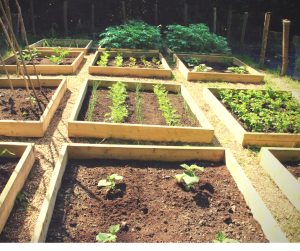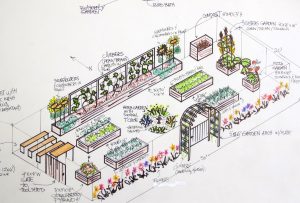10 Steps to a Dream Garden, before you plant
10 Steps to a Dream Garden
1. Identify WHY you want a garden.
Consider how you intend to utilize it and who else will derive enjoyment from the outdoor space. Recognize that you may not be the sole user, so gather input from all family members to understand how the garden will be utilized collectively.
Check Out: My Garden Sanctuary to learn more about making the garden a dream location
 2. Do a little dreaming.
2. Do a little dreaming.
3. Make a list of “must haves”.
Before you start digging and planting, it’s important to take some time to think about what you really want and need in your backyard. What are your must-have items? What are your dream features? Once you have a good understanding of your needs, you can start to create a plan that will make your backyard dreams a reality.
Listing Your Needs
Here are some essential items to consider for your backyard design:
- Retaining wall: If you have a sloped yard, a retaining wall can help to create a more level and usable space. It can also add visual interest and help to prevent erosion.
- Privacy fence: If you want to create a more private and secluded backyard, a privacy fence is a good option. There are many different styles of privacy fences to choose from, so you can find one that fits your budget and taste.
- Path to the garage: A path to the garage is essential for both functionality and aesthetics. It will make it easier to get to your garage, and it will also add a finished look to your backyard.
- More parking space: If you frequently have guests over, you may want to consider adding more parking space to your backyard. This will make it easier for your guests to find a place to park, and it will also free up space on the street.
- Play area for children: If you have children, a play area is a must-have. There are many different ways to create a play area, so you can find one that fits your space and your children’s interests.
- Pet area: If you have pets, you will want to create a designated area for them. This could be a simple fenced-in area, or it could be more elaborate, with a dog house, agility equipment, and a swimming pool.
Walking Your Property
Once you have a list of essential items, take some time to walk around your property and make note of any other things that you think are important. This could include things like the size and shape of your yard, the amount of shade, and the type of soil.
Balancing Dream Features and Must-Haves
It is important to strike a balance between your dream features and your must-haves. You may not be able to afford to do everything you want right away, so you will need to prioritize. Make a list of your top priorities, and then work your way down the list as you have the time and money.
Creating a Satisfying and Functional Space
By taking the time to plan and prioritize, you can create a backyard that is both satisfying and functional. Your backyard should be a space that you and your family can enjoy for years to come.
4. Evaluate what you already have.
5. Ballpark your budget.
Once you know what you want and what you need, it’s time to consider what you are willing to spend. This dollar figure will influence what features you include in the final garden plan — trees, plants, hardscape materials and architectural elements such as arbors, fountains, ponds and benches.
Remember that your “budget” comprises two elements: money and TIME. In terms of time, does the garden need to be finished by a certain date or can you create it over time? (Speed costs!) Also, how much time are you willing to budget to maintain your dream garden? Can you spare several hours a week or are you lucky enough to afford a caretaker?
As you develop and refine your plan, you may need to balance time and cash costs. Be flexible. You may need to spend more time if you can’t spend more money and vice versa.
 6. Identify your garden’s focal points.
6. Identify your garden’s focal points.
Every garden deserves a captivating centerpiece, a point of interest that draws the admiring gaze and invites a moment of pause. By selecting a focal point, you are consciously guiding the eye of visitors as they step into your verdant oasis. Perhaps your wish list envisioned the soothing tranquility of a cascading waterfall or the gentle murmur of a bubbling fountain. Or maybe you dreamed of a secluded arbor retreat, a haven of tranquility amidst the vibrant tapestry of nature. If so, you’re already on the path to identifying the focal point – or points – that will transform your garden into an enchanting masterpiece.
7. Create a rough design.
Take all the information that you’ve gathered and incorporate it into a workable design that balances the “wants” with the “must haves”. Your goal is to create a space that is both satisfying and functional.
Buy a pad of graph paper that contains 8 or 10 squares per inch and let each square equal one foot. (In other words, every inch on the paper will equate to 8 or 10 feet on your property.) Create a basic map with your property lines and house drawn to scale.
You will also need tracing paper, markers, a tape measure, a ruler, a pencil and a good eraser. Lay the tracing paper over your basic scaled map. Then refer back to your list of “must haves” and “wants” as you sketch the various areas of your garden. Show the approximate position of focal points, activity areas (“rooms”) and pathways. Use as many sheets of tracing paper as necessary until you find a layout that pleases you and meets the goal that you identified in Step 1.
When designing your dream garden, make it a part of your total landscape design plan.
8. Choose your plants and hardscape.
The colors and materials that you choose will create the character of your garden, adding interest, movement and visual appeal. Do you want harmonious colors or strong contrast? Warm hues or cool tones? Bold colors or soft hues? Mixing different colors and materials and textures will give your garden a strong sense of space.
Plants comprise a significant part of your garden. In addition to plants, hardscape materials contribute variety and texture — wood arbors, brick borders, gravel paths, bronze statuary, and wrought-iron benches.
As you review your preliminary layout, consider the best material for each of the hardscape elements. Keep in mind that each element needs to fit with and compliment the whole. For example, a terrace constructed of the same material as the house unifies while railroad ties around a formal garden create discord.
 9. Make a scale drawing.
9. Make a scale drawing.
Thus far, you have created a basic map of property lines and your house as well as an overlay sheet that shows focal points, “rooms” and pathways. You also have a list of the trees, shrubs and plants for each area of your garden. Now you need to create a scale drawing that shows EXACTLY where each feature will go. You will use this blueprint to lay the walkways, set the arbors and trellises, and plant the trees, shrubs and flowers.
It is important that you have enough information to help you create in reality the garden that you just designed on paper. As long as your scale drawing or blueprint is in sufficient scale to accomplish that purpose, you will be successful.
10. Execute your plan.
Before you begin actual construction of the garden, check all local building codes and regulations to make sure that you will be in compliance. Structures such as decks, patios and retaining walls may require a permit from the local city government. Once all permits are in place, you can start to lay out the garden.
With your scale drawing as a blueprint, use a tape measure to position all structures, walkways and plants. Be sure to measure accurately so each element in your design fits its assigned space.
If designing a garden space sounds a bit intimidating, don’t panic. Just follow these steps one by one and let a space unfold that feels right to you. You CAN do it. After all, a successful garden is just another room of your house, which you’ve already successfully decorated!


